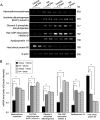Identification of changed proteins by retinoic acid in cerebral ischemic damage: a proteomic study
- PMID: 35831120
- PMCID: PMC9523306
- DOI: 10.1292/jvms.22-0119
Identification of changed proteins by retinoic acid in cerebral ischemic damage: a proteomic study
Abstract
Ischemic stroke is a severe neurodegenerative disease with a high mortality rate. Retinoic acid is a representative metabolite of vitamin A. It has many beneficial effects including anti-inflammatory, anti-apoptotic, and neuroprotective effects. The purpose of this study is to identify specific proteins that are regulated by retinoic acid in ischemic stroke. Middle cerebral artery occlusion (MCAO) was performed to induce focal cerebral ischemia. Retinoic acid (5 mg/kg) or vehicle was injected intraperitoneally into male rats for four days prior to MCAO operation. Neurobehavioral tests were performed 24 hr after MCAO and the cerebral cortex was collected for proteomic study. Retinoic acid alleviates neurobehavioral deficits and histopathological changes caused by MCAO. Furthermore, we identified various proteins that were altered by retinoic acid in MCAO damage. Among these identified proteins, adenosylhomocysteinase, isocitrate dehydrogenase [NAD+] subunit α, glycerol-3-phosphate dehydrogenase, Rab GDP dissociation inhibitor β, and apolipoprotein A1 were down-regulated in MCAO animals with vehicle treatment, whereas retinoic acid treatment alleviated these reductions. However, heat shock protein 60 was up-regulated in MCAO animals with vehicle, while retinoic acid treatment attenuated this increase. The changes in these expressions were confirmed by reverse transcription-PCR. These proteins regulate cell metabolism and mediate stress responses. Our results demonstrated that retinoic acid attenuates the neuronal damage by MCAO and regulates the various protein expressions that are involved in the survival of cells. Thus, we can suggest that retinoic acid exerts neuroprotective effects on focal cerebral ischemia by modulation of specific proteins.
Keywords: cerebral ischemia; neuroprotection; proteomics; retinoic acid.
Conflict of interest statement
The authors reported no proprietary or commercial interest in any product mentioned or concept discussed in this article.
Figures




Similar articles
-
Retinoic acid exerts neuroprotective effects against focal cerebral ischemia by preventing apoptotic cell death.Neurosci Lett. 2021 Jul 13;757:135979. doi: 10.1016/j.neulet.2021.135979. Epub 2021 May 20. Neurosci Lett. 2021. PMID: 34023410
-
Retinoic acid attenuates ischemic injury-induced activation of glial cells and inflammatory factors in a rat stroke model.PLoS One. 2024 Mar 25;19(3):e0300072. doi: 10.1371/journal.pone.0300072. eCollection 2024. PLoS One. 2024. PMID: 38527023 Free PMC article.
-
Retinoic Acid Prevents the Neuronal Damage Through the Regulation of Parvalbumin in an Ischemic Stroke Model.Neurochem Res. 2023 Feb;48(2):487-501. doi: 10.1007/s11064-022-03769-9. Epub 2022 Oct 16. Neurochem Res. 2023. PMID: 36245066
-
Retinoic acid alleviates the reduction of Akt and Bad phosphorylation and regulates Bcl-2 family protein interactions in animal models of ischemic stroke.PLoS One. 2024 May 16;19(5):e0303213. doi: 10.1371/journal.pone.0303213. eCollection 2024. PLoS One. 2024. PMID: 38753710 Free PMC article.
-
Chlorogenic acid alleviates neurobehavioral disorders and brain damage in focal ischemia animal models.Neurosci Lett. 2021 Aug 24;760:136085. doi: 10.1016/j.neulet.2021.136085. Epub 2021 Jun 24. Neurosci Lett. 2021. PMID: 34174343
Cited by
-
Proteomic advance of ischemic stroke: preclinical, clinical, and intervention.Metab Brain Dis. 2023 Dec;38(8):2521-2546. doi: 10.1007/s11011-023-01262-y. Epub 2023 Jul 13. Metab Brain Dis. 2023. PMID: 37440002 Review.
References
-
- Chen HJ, Shen YC, Shiao YJ, Liou KT, Hsu WH, Hsieh PH, Lee CY, Chen YR, Lin YL. 2015. Multiplex brain proteomic analysis revealed the molecular therapeutic effects of buyang huanwu decoction on cerebral ischemic stroke mice. PLoS One 10: e0140823. doi: 10.1371/journal.pone.0140823 - DOI - PMC - PubMed
MeSH terms
Substances
LinkOut - more resources
Full Text Sources
Medical
Research Materials

